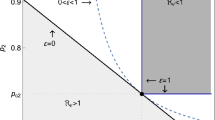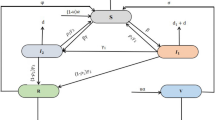Abstract
A new quantity called the target reproduction number is defined to measure control strategies for infectious diseases with multiple host types such as waterborne, vector-borne and zoonotic diseases. The target reproduction number includes as a special case and extends the type reproduction number to allow disease control targeting contacts between types. Relationships among the basic, type and target reproduction numbers are established. Examples of infectious disease models from the literature are given to illustrate the use of the target reproduction number.



Similar content being viewed by others
References
Allen LJS, Lahodny GE Jr (2012) Extinction thresholds in deterministic and stochastic epidemic models. J Biol Dyn 6:590–611. doi:10.1080/17513758.2012.665502
Anderson RM, May RM (1991) Infectious diseases of humans: dynamics and control. Oxford University Press, Oxford
Bani-Yaghoub M, Gautam R, Shuai Z, van den Driessche P, Ivanek R (2011) Reproduction numbers for infections with free-living pathogens growing in the environment. J Biol Dyn 6:923–940. doi:10.1080/17513758.2012.693206
Berman A, Plemmons RJ (1979) Nonnegative matrices in the mathematical sciences. Academic Press, New York
Chow L, Fan M, Feng Z (2011) Dynamics of a multigroup epidemiological model with group-targeted vaccination strategies. J Theor Biol 291:56–64. doi:10.1016/j.jtbi.2011.09.020
Diekmann O, Heesterbeek JAP (2000) Mathematical epidemiology of infectious diseases. Wiley, West Sussex, England
Diekmann O, Heesterbeek JAP, Roberts MG (2010) The construction of next-generation matrices for compartmental epidemic models. J R Soc Interfac 7:873–885. doi:10.1098/rsif.2009.0386
Edwards R, Kim S, van den Driessche P (2010) A multigroup model for a heterosexually transmitted disease. Math Biosci 224:87–94. doi:10.1016/j.mbs.2009.12.008
Farmer P, Almazor CP, Bahnsen ET, Barry D, Bazile J, Bloom BR, Bose N, Brewer T, Calderwood SB, Clemens JD, Cravioto A, Eustache E, Jrme G, Gupta N, Harris JB, Hiatt HH, Holstein C, Hotez PJ, Ivers LC, Kerry VB, Koenig SP, Larocque RC, Landre F, Lambert W, Lyon E, Mekalanos JJ, Mukherjee JS, Oswald C, Pape JW, Rabinovich R, Raymonville M, Rjouit JR, Ronan LJ, Rosenberg ML, Ryan ET, Sachs JD, Sack DA, Surena C, Suri AA, Ternier R, Waldor MK, Walton D, Weigel JL (2011) Meeting cholera’s challenge to Haiti and the world: a joint statement on cholera prevention and care. PLoS Negl Trop Dis 5(5):e1145. doi:10.1371/journal.pntd.0001145
Gourley SA, Thieme HR, van den Driessche P (2011) Stability and persistence in a model for bluetongue dynamics. SIAM J Appl Math 71:1280–1306. doi:10.1137/090775014
Harary F (1972) Graph theory. Addison-Wesley, Reading
Heesterbeek JAP, Roberts MG (2007) The type-reproduction number \(T\) in models for infectious disease control. Math Biosci 206:3–10. doi: 10.1016/j.mbs.2004.10.013
Horn RA, Johnson CR (1985) Matrix analysis. Cambridge University Press, Cambridge
Kolotilina LYu (1993) Lower bounds for the Perron root of a nonnegative matrix. Linear Algebra Appl 180:133–151. doi:10.1016/0024-3795(93)90528-V
Li MY, Shuai Z (2010) Global-stability problem for coupled systems of differential equations on networks. J Differential Equ 248:1–20. doi:10.1016/j.jde.2009.09.003
Lloyd AL, May RM (1996) Spatial heterogeneity in epidemic models. J Theor Biol 179:1–11. doi:10.1006/jtbi.1996.0042
Pulliam JRC, Epstein JH, Dushoff J, Rahman SA, Bunning M, Jamaluddin AA, Hyatt AD, Field HE, Dobson AP, Daszak P, The Henipavirus Ecology Research Group (2012) Agricultural intensification, priming for persistence and the emergence of Nipah virus: a lethal bat-borne zoonosis. J R Soc Interfac 9:89–101. doi:10.1098/rsif.2011.0223
Roberts MG, Heesterbeek JAP (2003) A new method for estimating the effort required to control an infectious disease. Proc R Soc Lond B 270:1359–1364. doi:10.1098/rspb.2003.2339
van den Driessche P, Watmough J (2002) Reproduction numbers and sub-threshold endemic equilibria for compartmental models of disease transmission. Math Biosci 180:29–48. doi:10.1016/S0025-5564(02)00108-6
West DB (1996) Introduction to graph theory. Prentice Hall, Upper Saddle River
Acknowledgments
The research of Z.S. and P.vdD was supported in part by a Natural Science and Engineering Research Council of Canada (NSERC) Postdoctoral Fellowship, an NSERC Discovery Grant and the Mprime-NCE project “Transmission Dynamics and Spatial Spread of Infectious Diseases: Modelling, Prediction and Control”. J.A.P.H. thanks this project for a visit to Canada, which initiated this collaboration. Z.S. and P.vdD thank Dr. L.J.S. Allen for helpful discussions on material in Sect. 4 and providing a preprint of Allen and Lahodny (2012).
Author information
Authors and Affiliations
Corresponding author
Appendix
Appendix
Proof of Theorem 2.1
Observe that \(I-(K-P_{S_1}KP_{S_2})\) is a nonsingular \(M\)-matrix since \(K-P_{S_1}KP_{S_2}\) is nonnegative with spectral radius less than 1. For definition and properties of \(M\)-matrices, see Berman and Plemmons (1979). It follows that \(M:= P_{S_1} K P_{S_2} (I-K+P_{S_1} K P_{S_2})^{-1}\) is nonnegative, and \((I-M)P_{S_1}KP_{S_2}=M(I-K)\). Since \(S_1\) includes all indices of rows where \(M\) has nonzero entries, it follows that \(\rho (M)=\rho (E_{S_1}ME_{S_1})=\mathcal T _{S}\). Let \(w\) be a positive eigenvector of the nonnegative irreducible matrix \(K\) with respect to \(\rho (K)=\mathcal R _0\). Then
Notice that all indices of nonzero rows of \(M\) are included in \(S_1\). Also notice that \(P_{S_1}KP_{S_2}w\) is a vector in \(\mathbb R ^n\) with positive entries only in each position \(j \in S_1\). If \(\mathcal R _0=\rho (K)<1\), then \((1-\mathcal R _0)Mw>0\), thus (6.1) gives \(MP_{S_1}KP_{S_2}w<P_{S_1}KP_{S_2}w\). By applying a result of Collatz to the rows whose indices are included in \(S_1\) (see, for example, (Horn and Johnson 1985, Corollary 8.1.29)), \(\mathcal T _S=\rho (M)<1\). If \(\mathcal T _S<1\), then \(\mathcal R _0<1\) from (6.1). Similarly, it can be shown that \(\mathcal R _0=1\) iff \(\mathcal T _S=1\), and \(\mathcal R _0>1\) iff \(\mathcal T _S>1\). \(\square \)
Proof of Theorem 2.2
Since each targeted entry of \(K\) appears only in the term \(P_{S_1}KP_{S_2}\) in (2.1), \(\mathcal T _S\) depends linearly on the targeted entry. Let \(\mathcal T _{S}^c\) be the target reproduction number corresponding to \(K_c\), thus \(\mathcal T _{S}^c =\mathcal T _{S}/\mathcal T _{S}=1\), which implies \(\rho (K_c)=1\), by Theorem 2.1. \(\square \)
Proof of Theorem 4.2
Consider the next-generation matrix \(K^T\), the transpose of \(K\), and let \({\hat{\mathcal{T }}_S}\) be the corresponding target reproduction number with respect to the target \(S\) (i.e., \(K\) in (2.1) is replaced by \(K^T\)). Let \({\hat{K}_{c}}\) be the controlled next-generation matrix corresponding to \(K^T\) and target set \(S\), defined as in Theorem 2.2; that is, the \((i,j)\) entry \(k_{ji}\) in \(K^T\) is replaced by \(k_{ji}/{\hat{\mathcal{T }}}_S\) if \((i,j)\in S\). Similarly, let \(K_{\hat{c}}\) be the controlled next-generation matrix corresponding to \(K\) and target set \(S^T\); that is, the \((j,i)\) entry \(k_{ji}\) in \(K\) is replaced by \(k_{ji}/\mathcal T _{S^T}\) if \((i,j) \in S\). Notice that if \(\mathcal T _{S^T}={\hat{\mathcal{T }}}_S\), then \({\hat{K}_c}=(K_{\hat{c}})^T\) and \(\rho ({\hat{K}_c})=\rho (K_{\hat{c}})\). Now suppose that \(\mathcal T _{S^T}\not ={\hat{\mathcal{T }}}_S\), then either \(k_{ji}/{\hat{\mathcal{T }}}_S>k_{ji}/\mathcal T _{S^T}\) for all \((i,j)\in S\), or \(k_{ji}/{\hat{\mathcal{T }}}_S<k_{ji}/\mathcal T _{S^T}\) for all \((i,j)\in S\). By the monotone property of the spectral radius of nonnegative irreducible matrices (e.g., see (Berman and Plemmons 1979, p. 27)), \(\rho (K_{\hat{c}}) \not =\rho ({\hat{K}_c})\), contradicting \(\rho (K_{\hat{c}}) =\rho ({\hat{K}_c})=1\) required by Theorem 2.2. Hence, \(\mathcal T _{S^T}={\hat{\mathcal{T }}_S}\).
On the other hand, since \(K\) is irreducible and the associated weighted digraph \(\mathcal G \) is weight balanced, there exists a nonsingular \(n\times n\) diagonal matrix \(D\) such that \(M=DKD^{-1}\) is symmetric; see, for example, Corollary 1 in Kolotilina (1993). It follows that \(DKD^{-1}=M=M^T=(DKD^{-1})^T=D^{-1}K^T D\), and thus \(K^T=D^2 K (D^{-1})^2\). Hence
Therefore, \(\mathcal T _S=\mathcal T _{S^T}\). \(\square \)
Proof of Theorem 4.3
It follows from Theorem 2.1 that \(\mathcal T _S = \mathcal T _U =1\) if and only if \(\mathcal R _0=1\), and that \(\mathcal T _S>1\) and \(\mathcal T _U>1\) if \(\mathcal R _0>1\). The relation between \(\mathcal T _S\) and \(\mathcal T _U\) for \(\mathcal R _0>1\) is proved by contradiction. Suppose that \(\mathcal T _U>\mathcal T _S\). Let \(K_{c_S}\) and \(K_{c_U}\) be the controlled next-generation matrices defined as in Theorem 2.2, that is, the entry \(k_{ij}\) in the next-generation matrix \(K\) is replaced by \(k_{ij}/\mathcal T _S\) (or \(k_{ij}/\mathcal T _U\)) if \((i,j)\in S\) (or \((i,j)\in U\)). Since \(\mathcal T _U>\mathcal T _S>1\) and \(S\subset U\), it follows that \(K_{c_S} > K_{c_U}\). Hence, by the monotone property of the spectral radius of nonnegative irreducible matrices (e.g., see (Berman and Plemmons 1979, p. 27)), \(\rho (K_{c_S}) > \rho (K_{c_U})\), contradicting \(\rho (K_{c_S}) = \rho (K_{c_U})=1\) required by Theorem 2.2. Therefore, \(\mathcal T _S > \mathcal T _U >1\) if \(\mathcal R _0>1\). A similar argument can be used to show that \(\mathcal T _S < \mathcal T _U < 1\) if \(\mathcal R _0<1\). \(\square \)
Rights and permissions
About this article
Cite this article
Shuai, Z., Heesterbeek, J.A.P. & van den Driessche, P. Extending the type reproduction number to infectious disease control targeting contacts between types. J. Math. Biol. 67, 1067–1082 (2013). https://doi.org/10.1007/s00285-012-0579-9
Received:
Revised:
Published:
Issue Date:
DOI: https://doi.org/10.1007/s00285-012-0579-9
Keywords
- Infectious disease control
- Basic reproduction number
- Type reproduction number
- Target reproduction number




